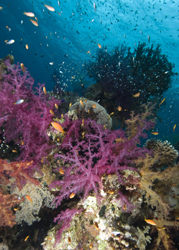Seamounts - an OASIS in the Atlantic
The OASIS project and the World Wide Fund for Nature (WWF) North-East Atlantic Marine Ecoregion (NEAME) produced a joint report reviewing the current state of knowledge for seamounts in the North-East Atlantic. Seamounts are mountains of volcanic origin which rise up from the seafloor but remain below the surface of the water. They often reach the photosynthetic zone, enabling them to become a haven for biological activity and biodiversity. Shallow seamounts act as stepping stones, enabling species to disperse across the Atlantic. The rock which forms seamounts is much harder than the sediment of the surrounding ocean floor. The steep slopes of the seamount deflect ocean currents creating an upwelling, which brings valuable nutrients. The hard substrate and abundant nutrients provide ideal conditions for suspension feeders. Compared to the surrounding ocean, these sites contain great numbers of plankton which attract fish and squid and in turn, draw predators such as sharks, tuna and swordfish. Some of the fish species found in this environment are exceptionally long-lived and slow to mature, making them highly vulnerable to overexploitation. In the majority of cases commercial fishing has taken place before the biology and life history of the target species could be understood. In the absence of proper assessment and quotas some stocks have crashed. Commercially important species are caught using longline fishing, mid-water trawling and bottom trawling to a depth of 1,500 metres. Drift nets and purse seines are also used. Unfortunately, commercial fishing has resulted in the deaths of non-target species including thousands of seabirds, dolphins and sea turtles. Political initiatives at the international, North-East Atlantic, regional and national level have been undertaken to address the environmental impact of human activity on seamounts. These have included a call by the United Nations to improve the management of these sites and the establishment of Marine protected areas (MPAs) acknowledged by assemblies such as the Convention on Biodiversity. A seamount in the Azores was the first to be protected under the EUs Natura 2000 network of protected areas. The OASIS and WWF report will help policy makers and stakeholders to draft suitable measures for the conservation and sustainable management of these biodiversity hot spots.







